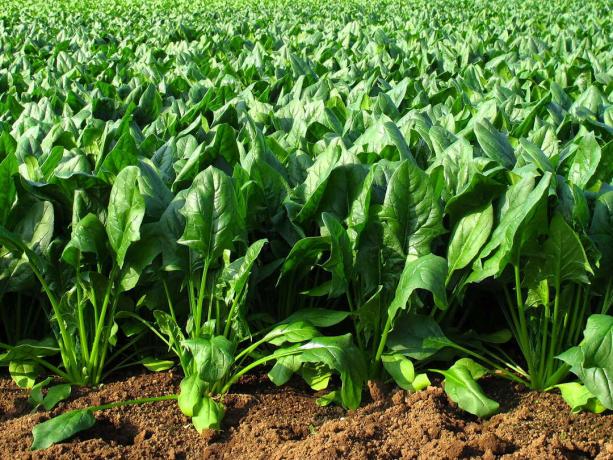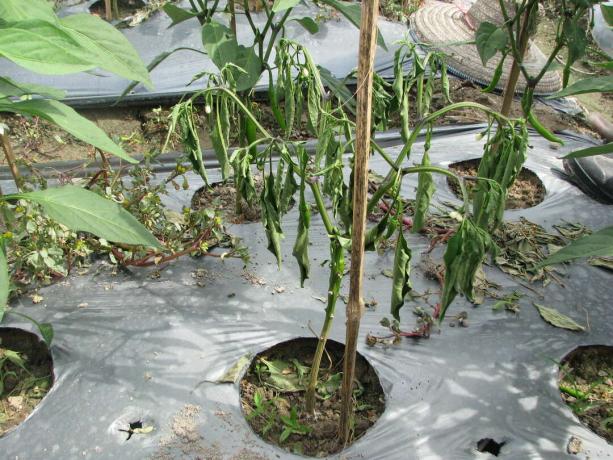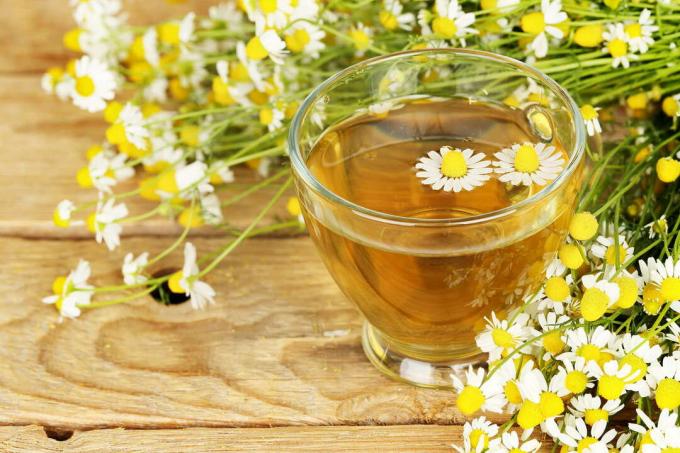Fusarium is a diverse genus of fungi that, in addition to plant damage, also causes nail fungus. You can find out how to recognize and fight it early on here.

The genus Fusarium includes many different types and is able to form so-called mycotoxins (mold toxins). Therefore, Fusarium threatens not only our plants, but also the feeds of animals and us. There are even fusaria that can attack humans and animals. What exactly one under Fusarium understands which plants it is particularly common on, how to recognize it at an early stage and successfully control it, you will find in this article.
contents
- Fusarium: a profile
- The life cycle of Fusarium
-
Fusarium species: different species, different plants
- Fusarium oxysporum
- Fusarium graminearum
- Fusarium solani
- Fusarium venenatum
- Fusarium culmorum
- Recognize Fusarium quickly
-
Fighting Fusarium successfully
- Pesticides against Fusarium
- Naturally expel and prevent Fusarium
- Mycotoxins: what about DON, ZON and NIV?
Fusarium: a profile
The fusaria are sac fungi (Ascomycota) and belong to the pustule family (Nectriaceae).
The Fusarium are characterized by their wide host range, because they can attack grain, grass and vegetables. the Fusarium solani-Group not only affects plants, but also animals and people. Fusaria can be found in the soil or on plants around the world and are even a problem when storing food.
The life cycle of Fusarium
It is common for mushrooms to have a major fruit form and a minor fruit form. The main fruit form is characterized by sexual reproduction, the secondary fruit form by asexual reproduction. Some of the fusariae have both fruit forms, while with some only the minor fruit form is known - therefore these fusariae belong to the Fungi imperfecti.
The fungus persists in the soil or on plant remains and can persist there for a longer period of time. Fusarium overwinters and colonizes the remaining plant remains as a mycelium. When the plants begin to grow due to the weather in spring, the fungus begins to develop too.
Warm and humid weather is ideal for the development of the main fruit form, the perithecium. The so-called perithecia are the fruiting bodies of the fungus in which the ascospores form. These spores are released on the harvest residues at temperatures of 11 to 30 ° C and at a humidity of 60 to 90%. These spores can survive in the soil for up to two years and are extremely sticky. The fruiting bodies can also actively eject these spores - they then spread through air movements.

The asexually formed spores, the so-called conidia, can also cover longer distances. These spores are spread by splashes of rain, wind, and insects. There are also long-lived chlamydospores that can even infect the roots.
When the spores encounter a suitable host plant, the infection begins with the germination of the spores and the growth of the hyphae on the plant surface. The fungus then penetrates the plant through the stomata or directly through the tissue. When the fungus has settled and developed on the plant, conidia carriers form. There the asexual conidia are formed and released by spray water - which in turn infects other plants. In the meantime, the fungus also develops various mycotoxins (fungal poisons).
In autumn the spores survive again on the crop residues or in the soil and the cycle starts all over again.
Fusarium species: different species, different plants
In the following we have compiled various species of Fusarium for you, as well as the plants on which they occur.
Fusarium oxysporum
These Fusarium-Art is one of the most feared fungal diseases and usually causes wilting. In the USA, this fungus was even researched under the name “Agent Green” for use as a biological weapon. Fusarium oxysporum leads to different symptoms in different cultures. Generally there is wilting, yellowing and deformation of leaves and also root rot. Often the vessels also rot and discolour. Here is an overview of the symptoms:
Cabbage vegetables like Kohlrabi (Brassica olearceae var. gongylodes) or Brussels sprouts (Brassica olearacea var. gemmifera):
- Fusarium-Wilt caused by Fusarium oxysporum f. sp. conglutinans
- Can only develop from 16 ° C
- Optimal development conditions: 24 to 29 ° C
- Leaves turn yellow, deform, and fall off
- Cabbage plants wither and die
spinach (Spinacia):
- Wilt and root rot caused by Fusarium oxysporum f. sp. spinaciae
- Is transmitted through the seed

Tuber and root vegetables:
- Vascular and wilting disease through Fusarium oxysporum f. sp. raphani
- Reduced growth
- Chlorosis and necrosis on the leaves
- Tubers stay small
- Vascular bundles turn reddish-brown to black
Onion vegetables like Onions (Allium cepa):
- Onion basal rot through Fusarium oxysporum f. sp. cepae
- Rot at the bottom of the onion
- Yellowing of the leaves starting from the tip of the leaf
- Shrinking and rotting of the leaves
- Weak roots; Onions are easy to pull out of the ground
French and runner beans:
- Bean wilt through Fusarium oxysporum f. sp. phaseoli
- The lower bean leaves turn yellow, yellowing increases from bottom to top
- Discoloration often only occurs on one side of the plant
- The vessels in the stem turn brown
- Transmission through the seed
peas (Pisum sativum):
- Fusarium wilt through Fusarium oxysporum f. sp. pisi occurs in 2 types:
- American wilt (race 1)
- From the end of May (before the pea blossom)
- Rolled leaves with a dirty green color
- Wither and wither
- Discolored vessels in orange, red, yellow and black
- St. John's disease (race 2)
- From the end of June (end of pea blossom, start of pod formation)
- Pale green rolled leaves and shoots
- Often only on one side of the plant
- Vessels turn brick-red
- American wilt (race 1)
Tomatoes (Solanum lycopersicum):

Fusarium-Foot disease through Fusarium oxysporum f. sp. radicis-lycopersici
- Stem and root rot
- Infestation through the roots
- The bottom 30 cm of the stem turns brown
- A white-pink mold lawn forms on the soft rotten spots on the stem

Fusarium graminearum
These Fusarium-Type causes in grains such as wheat (Triticum) or barley (Hordeum) Deafness or also called ear fusariosis. The grains shrink and stay small. The ears are pale and there is often an orange or pink coating of spores. For maize (Zea mays) piston rot occurs. Fusarium- Infestation in grain leads to yield losses and the formation of mycotoxins, which can be harmful to humans and animals.

Fusarium solani
- potatoes:
For potatoes (Solanum tuberosum) caused Fusarium solani the dry rot, which is also called white rot. This rot occurs in the warehouse and causes a whitish-bluish fungal lawn to form on the potato tubers. Under this mushroom lawn, the tuber begins to rot and lose water. The infected areas shrink and the potatoes look wrinkled. The loss of water makes the potato hard and powdery dry. It may after Fusarium-Infection can also lead to a second bacterial infection. This then creates a wet rot.
- peas:
If the leaves of peas turn yellow in the upper area and the base of the stem is reddish-brown, this could be the cause Fusarium solani f. sp. pisi be. This fungus occurs from the flower base and root rot occurs. Damage to the plant occurs particularly in drought and heat after an excessively humid period. This root rot can also occur in beans and is often associated with St. John's disease.
- People:
What is particularly interesting is that Fusarium solani can also occur in humans and inflammation of the eyes (Endophthalmitis), Corneal inflammation (Keratitis) or sinus infections (Sinusitis) caused. These diseases are caused by the mycotoxins that Fusarium solani forms.
Fusarium venenatum
At this Fusarium-Type is only the secondary crop form Fusarium venenatum known, especially among vegetarians, as the meat substitute Quorn is made from this mold. Under controlled conditions will Fusarium venenatum grown, whereby the fungus produces a lot of mycoprotein, which serves as a raw material for the meat alternative. Quorn is available in Germany and Switzerland (known there as "Cornatur") and is used, for example, in vegetarian Bolognese sauces.

Fusarium culmorum
- Onion vegetables:
With the onion vegetables like leek (Allium porrum) or garlic (Allium sativum) a root rot occurs Fusarium culmorum on. This fungus is a wound parasite and causes yellowing and rot in the roots. Therefore, the plants grow only slightly, sometimes a bright red fungal network can be seen in the infected areas.
- Legumes:
Run on peas or beans Fusarium culmorum as Fusarium avenaceum often to root rot. Because root rot often occurs in a complex, so that several fungi are responsible for the damage to the roots. Often not only combinations of different Fusarium species can be found, Thielaviopsis basicola can also be found and cause black discoloration of the roots and rot.
Recognize Fusarium quickly
Since you usually don't have a microscope and laboratory equipment in the garden, you can Fusarium unfortunately not determined by its spore shape or the like. Therefore we can only orientate ourselves on the symptoms on our plants. The following symptoms are often associated with a Fusarium infection:
- Lightening or yellowing of the leaves
- Curling leaves
- Rot at the roots
- Discolored vessels
- White-pink mold lawn
- Wilt, often only on one side of the plant and in nests in the stand

Fighting Fusarium successfully
So that your vegetable harvest doesn't do that Fusarium- Fungus falls victim, here are a few tips and tricks for dealing with this dreaded pathogen.
Pesticides against Fusarium
For professional use in arable farming, there are some pesticides in the fight against Fusarium, At the moment only the fungicide “Prestop” is approved for the garden area.
This remedy works with the soil fungus Gliocladium catenulatum and can be used on fruit, cabbage and leafy vegetables as well as herbs. It can also be used for young plants and seedlings, strawberries and ornamental plants. The application can be done either by spraying or pouring. For more detailed instructions, please refer to the manufacturer's instructions.
Naturally expel and prevent Fusarium
So that yourself Fusarium does not spread to you, you should pay attention to the following things when planting:
- Only plant healthy and undamaged plants, bulbs or tubers
- Use resistant varieties
- Carry out seed dressing with chamomile tea
- Pay attention to crop rotation and cultivation breaks

If you are now to harvest no problems with Fusarium you should also take care to keep your bearings free.
Around Fusarium solani To avoid having potatoes in storage, it is advisable to only store healthy and undamaged potatoes. Injuries allow the fungus to invade the tubers and trigger the white rot. Finally, when storing potatoes, make sure not to store too much soil with them, because the fungus often ends up in the potato store with this. It is also important that the potatoes dry off quickly so that no permanent moisture develops.
Even with other types of vegetables, such as onions, you should not harvest too early and store the vegetables as dry as possible. Make sure that your warehouse is well ventilated here too. Like yours Properly harvest and store onions, find out here.
That was with cucumbers Fusarium-Wilt was a big problem in the 1950s. Therefore, at that time, the cucumbers were started on the fig leaf gourd (Cucurbita ficifolia) to graft, because this makes them resistant to Fusarium and generally more robust and less vulnerable.
It is particularly important when dealing with the pathogen that you always remove infected plants as soon as you have discovered them. You shouldn't dispose of these diseased plants on your compost, but in the garbage can.
As soon as you have a Fusarium-If you have discovered infection, you should take a break from cultivation. is Fusarium occurred on your tomatoes, do not put any tomatoes in this place for at least four to five years.
Mycotoxins: what about DON, ZON and NIV?
People keep telling you that it is unhealthy to eat food that has been infected by fungus. Often there are only tiny spots on the home-grown vegetables that indicate a mold lawn. In the following we will tell you why you should be particularly careful with mold and why boiling it doesn't make things any better.
Myctoxins are the secondary metabolic products of mold, i.e. not the fungus itself, but poisonous substances that are formed by the molds.
According to the World Food Organization (FAO), a quarter of the world's food is contaminated with mycotoxins; in the EU, mycotoxins can be found in a fifth of the harvested grain.

Since these mycotoxins are extremely stable, they are not destroyed by heat, for example in food production. The different types of poisons can have various effects on us and on animals, such as: Damage to our organs, nerves, our immune system and even to our genes.
Fortunately, these days there is no longer any need to worry about groceries from retailers. These are subject to strict maximum values in food production. Domestic animals and farm animals, on the other hand, can suffer great damage from moldy feed.
Here is a small list of myctoxins and their effects:
Fusaria form fumonisins, zearalenone and trichothecene and can cause the symptoms and diseases mentioned above. The trichothecenes include DON and NIV, among others.
Fusarium can lead to root rot on your plants. As Recognize, prevent and fight root rot, learn from this article.



